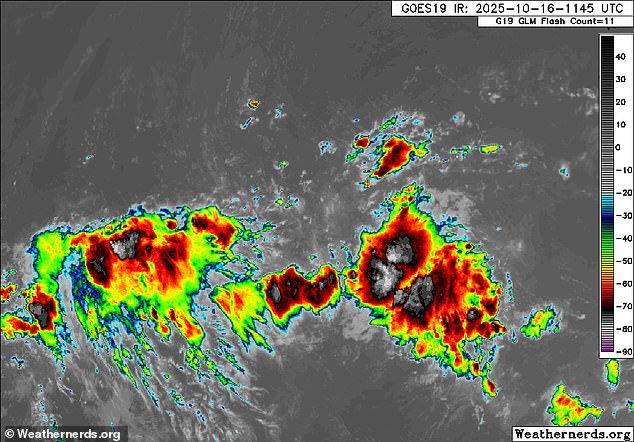A powerful tropical system brewing in the Atlantic Ocean could become the next major threat to lives and property in the US, meteorologists have warned.
Forecasters are tracking a tropical wave, a poorly organized area of showers and thunderstorms, currently located off the coast of Africa, which is expected to develop into a named storm between October 21 and 25.
If it strengthens, it will be called Melissa, the next name on the 2025 Atlantic hurricane season roster.
Meteorologist Brian Shields, known as Mr. Weatherman on YouTube, said that two leading models indicate the system could develop into a hurricane.
The more aggressive American GFS model predicts it could reach hurricane strength by late next week as it moves through the Caribbean, with the potential to turn north toward the southeastern US.
Shields also noted that the European model indicates hurricane development, with the storm approaching near the Florida coastline.
Experts have cautioned that while the exact path and intensity remain uncertain, warm Caribbean waters could fuel rapid strengthening, making preparedness crucial for coastal communities.
AccuWeather meteorologists issued an alert on Wednesday, saying they ‘are tracking what may become the next threat to lives and property in the Caribbean, Central America and potentially the US before the end of October.’

Meteorologists are monitoring a tropical wave moving west in the Atlantic Ocean, warning it could intensify in the coming days as it barrels closer to the US

Models have suggested that the tropical wave could become a tropical threat with a path to the US
The National Hurricane Center (NHC) issued an alert on Thursday, saying the system is moving west at 17mph and is showing scattered areas of moderate to strong thunderstorms.
AccuWeather chief on-air meteorologist Bernie Rayno said in a statement: ‘This is the tropical wave that could go on to define the Atlantic tropical season in terms of impact, should it get past hurdles in the coming days.’
Meteorologists noted multiple scenarios could play out, with one steering the storm northward to Florida.
‘In a worst-case scenario, the wave could organize into a tropical storm over the central Caribbean and move northward with a track near the US Atlantic coast,’ they warned.
However, AccuWeather noted that the tropical wave has a long way to go before entering the open waters of the Caribbean.
‘Should the system get past issues with dry air, combative winds (wind shear), and proximity to the equator, it could intensify quickly once it reaches the warm and virtually untouched waters of the Caribbean next week,’ DaSilva said.
While the path of the potential storm is unknown, it could follow a similar route to Hurricane Sandy in 2023, which hit New Jersey and New York, AccuWeather said.
But meteorologists emphasized that while this is not the most likely scenario at this time, there is a wide range of development and track possibilities.

In a worst-case scenario, the wave could organize into a tropical storm over the central Caribbean and move northward with a track near the US Atlantic coast
‘However, based on the anticipated weather pattern and historical records, the Caribbean could be the spot for the next tropical storm and hurricane to form and affect populated areas from next week to the end of the month,’ they said.
The Atlantic hurricane season officially continues through November 30.
As the peak period for tropical waves winds down in late October and November, new storms typically form near Central America, the central Atlantic, and the waters off the southeastern US coast.
By October 15, the season had produced four hurricanes, three of which reached major hurricane strength with sustained winds of 111 mph or higher.
In addition, there have been 12 named tropical storms and one unnamed storm of strong winds and heavy rain that impacted the US East Coast from October 10–14.
This article was originally published by a www.dailymail.co.uk . Read the Original article here. .

